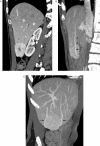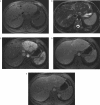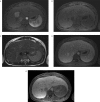Distinguishing benign from malignant liver tumours
- PMID: 17921080
- PMCID: PMC2727979
- DOI: 10.1102/1470-7330.2007.9084
Distinguishing benign from malignant liver tumours
Abstract
Liver masses are very common and most are benign. It is therefore important to avoid unnecessary interventions for benign lesions, while at the same time ensuring accurate diagnosis of hepatic malignancies. Many cancer patients, like the general population, have incidental benign liver lesions. In planning treatment for cancer patients, it is critical to avoid inappropriate treatment decisions based on misdiagnosis of a benign lesion as a metastasis or primary liver malignancy. This article describes the salient imaging features of the common benign liver masses and outlines a general approach to distinguishing between benign and malignant hepatic lesions.
Figures








Similar articles
-
Imaging of paediatric liver tumours with pathological correlation.Clin Radiol. 2009 Oct;64(10):1015-25. doi: 10.1016/j.crad.2009.04.014. Epub 2009 Jul 17. Clin Radiol. 2009. PMID: 19748008 Review.
-
[Benign focal hepatic lesions].Radiologe. 2011 Aug;51(8):688-96. doi: 10.1007/s00117-010-2127-1. Radiologe. 2011. PMID: 21809146 Review. German.
-
[Surgical treatment of benign liver tumours--indications and results].Zentralbl Chir. 2009 Apr;134(2):141-4. doi: 10.1055/s-2008-1076871. Epub 2009 Apr 20. Zentralbl Chir. 2009. PMID: 19382044 German.
-
Review article: the evaluation of solitary liver masses.Aliment Pharmacol Ther. 2008 Oct 15;28(8):953-65. doi: 10.1111/j.1365-2036.2008.03805.x. Epub 2008 Jul 16. Aliment Pharmacol Ther. 2008. PMID: 18643922 Review.
-
ACG Clinical Guideline: Focal Liver Lesions.Am J Gastroenterol. 2024 Jul 1;119(7):1235-1271. doi: 10.14309/ajg.0000000000002857. Epub 2024 Jan 26. Am J Gastroenterol. 2024. PMID: 38958301
Cited by
-
Differential diagnoses and diagnostic troubleshooting of upper abdominal masses.Gastroenterol Hepatol (N Y). 2013 Jun;9(6):399-400. Gastroenterol Hepatol (N Y). 2013. PMID: 23935549 Free PMC article. No abstract available.
-
[Benign liver tumors : Diagnostics and treatment].Chirurg. 2019 Dec;90(12):1033-1046. doi: 10.1007/s00104-019-01068-8. Chirurg. 2019. PMID: 31784769 German.
-
[Benign liver tumors : Diagnostics and treatment].Pathologe. 2020 Mar;41(2):181-192. doi: 10.1007/s00292-020-00758-z. Pathologe. 2020. PMID: 32103337 German.
-
Giant Cavernous Hemangioma of the Liver in a Patient with Autosomal Dominant Polycystic Kidney Disease.Am J Case Rep. 2020 Nov 18;21:e927188. doi: 10.12659/AJCR.927188. Am J Case Rep. 2020. PMID: 33206631 Free PMC article.
-
Imaging findings of mimickers of hepatocellular carcinoma.Clin Mol Hepatol. 2015 Dec;21(4):326-43. doi: 10.3350/cmh.2015.21.4.326. Epub 2015 Dec 24. Clin Mol Hepatol. 2015. PMID: 26770920 Free PMC article. Review.
References
-
- Wright TL, Venook AP, Millward-Sadler GH. GH M-S. Hepatic tumours. In: Millward-Sadler GH, Wright R, Arthur MJP, editors. Wright's liver and biliary disease. 3rd. Vol. 2. Philadelphia: WB Saunders; 1992. pp. 1079–21.
-
- Gibney RG, Hendin AP, Cooperberg PL. Sonographically detected hepatic hemangiomas: absence of change over time. AJR Am J Roentgenol. 1987;149:953–7. - PubMed
-
- Mungovan JA, Cronan JJ, Vacarro J. Hepatic cavernous hemangiomas: lack of enlargement over time. Radiology. 1994;191:111–13. - PubMed
-
- Nghiem HV, Bogost GA, Ryan JA, Lund P, Freeny PC, Rice KM. Cavernous hemangiomas of the liver: enlargement over time. AJR Am J Roentgenol. 1997;169:137–40. - PubMed
Publication types
MeSH terms
LinkOut - more resources
Full Text Sources
Medical
